Improving Mechanical Property of Hyper-Eutectic Al-Si Alloys via Regulating the Microstructure by Rheo-Die-Casting
Abstract
1. Introduction
2. Materials and Methods
2.1. Material Composition
2.2. Material Preparation by Rheo-Die-Casting
2.3. Sample Testing and Characterization
3. Results
4. Discussion
4.1. Nucleation of the Primary Si under RDC
4.2. Effect of RDC on Crystal Growth of the Primary Si
5. Conclusions
- 1.
- The semisolid slurry analysis revealed that increasing the rotational speed and pouring temperature resulted in the production of relatively finer and rounder primary Si. The aspect ratio of eutectic Si decreased with increasing pouring temperature but remained relatively constant with increasing rotational speed. After RDC, the dendritic aluminum matrix and iron-containing phase were sheared off.
- 2.
- The RDC alloy exhibited smaller and rounder primary Si compared to HPDC, with the eutectic Si and Al2Cu being finer and more dispersive. The RDC alloy demonstrated superior mechanical properties, with less porosity, making it heat treatable and resulting in an ultimate tensile property improvement of more than 20%.
- 3.
- RDC was found to break the Si-Si clusters, increasing the nucleation of primary Si. However, the strong shearing stress led to imperfect octahedral primary Si growth and the formation of cracks originating from {100} planes and propagating along {110} planes.
Author Contributions
Funding
Data Availability Statement
Conflicts of Interest
References
- Dai, H.S.; Liu, X.F. Refinement performance and mechanism of an Al-50Si alloy. Mater. Charact. 2008, 59, 1559–1563. [Google Scholar] [CrossRef]
- Gupta, M.; Ling, S. Microstructure and mechanical properties of hypohyper-eutectic Al-Si alloys synthesized using a near-net shape forming technique. J. Alloys Compd. 1999, 287, 284–294. [Google Scholar] [CrossRef]
- Vijayan, V.; Ravi, M.; Prabhu, K.N. Effect of Ni and Sr additions on the microstructure, mechanical properties, and coefficient of thermal expansion of Al-23%Si alloy. Mater. Today Proc. 2021, 46, 2732–2736. [Google Scholar] [CrossRef]
- Porawit, J.; Sukangkana, T. Microstructural Modification Hardness and Surface Roughness of Hypereutectic Al-Si Alloys by a Combination of Bismuth and Phosphorus. Crystals 2022, 12, 1026. [Google Scholar]
- Alexander, C.; Evgeny, M.; Martin, S. Effect of Rapid Quenching on the Solidification Microstructure, Tensile Properties and Fracture of Secondary Hypereutectic Al-18%Si-2%Cu Alloy. Metals 2020, 10, 819. [Google Scholar]
- Lee, J.M.; Kang, S.B.; Yoon, S.C. Role of the primary silicon particle on the dry sliding wear of hypereutectic aluminium-silicon alloy A390. Met. Mater. Int. 1999, 5, 357–362. [Google Scholar] [CrossRef]
- Jasim, K.M.; Dwarakadasa, E.S. Dry sliding wear in binary Al-Si alloys at low bearing pressures. J. Mater. Sci. Lett. 1992, 11, 421–423. [Google Scholar] [CrossRef]
- Mcdonald, S.D.; Nogita, K.; Dahle, A.K. Eutectic nucleation in Al-Si alloys. Acta Mater. 2004, 52, 4273–4280. [Google Scholar] [CrossRef]
- Nafisi, S.; Ghomashchi, R.; Vali, H. Eutectic nucleation in hypoeutectic Al-Si alloys. Mater. Charact. 2008, 59, 1466–1473. [Google Scholar] [CrossRef]
- Xu, C.L.; Jiang, Q.C.; Yang, Y.F.; Wang, H.Y.; Wang, J.G. Effect of Nd on primary silicon and eutectic silicon in hypereutectic Al-Si alloy. J. Alloys Compd. 2006, 422, L1–L4. [Google Scholar] [CrossRef]
- Liao, H.; Sun, G. Mutual poisoning effect between Sr and B in Al-Si casting alloys. Scripta Mater. 2003, 48, 1035–1039. [Google Scholar] [CrossRef]
- Nogita, K.; Mcdonald, A.K.; Dahle, A.K. Effects of boron-strontium interactions on eutectic modification in Al-10 mass%Si alloys. Mater. Trans. 2003, 44, 692–695. [Google Scholar] [CrossRef]
- Guoling, M.; Guangzr, T.; Wenli, G.; Shanguang, L.; Liwei, Z. The poisoning effect of Sc or Zr in grain refinement of Al-Si-Mg alloy with Al-Ti-B. Mater. Lett. 2021, 302, 130428. [Google Scholar]
- Kai, Q.; Guo, X.; Fengjiang, W. Interfacial Behavior and Shear Strength of Al-25Si-4Cu-1Mg Joints by Transient Liquid Phase Bonding with Cu as Interlayer. Metals 2021, 11, 1637. [Google Scholar]
- Ji, S.; Fan, Z.; Bevis, M.J. Semi-solid processing of engineering alloys by a twin-screw rheomoulding process. Mat. Sci. Eng. A 2001, 299, 210–217. [Google Scholar] [CrossRef]
- Flemings, M.C. Behavior of metal alloys in the semisolid state. Metall. Trans. B 1991, 22, 269–293. [Google Scholar] [CrossRef]
- Martinez, R.A.; Flemings, M.C. Evolution of particle morphology in semisolid processing. Metall. Mater. Trans. A 2005, 36, 2205–2210. [Google Scholar] [CrossRef]
- Sukangkana, T.; Charinrat, P.; Phuriphut, S. Thixoforming and Rheo-Die-Casting of A356/SiC Composite. Metals 2020, 10, 251. [Google Scholar]
- Guan, R.G.; Zhao, Z.Y.; Lee, C.S.; Zhang, Q.S.; Liu, C.M. Effect of wavelike sloping plate rheocasting on microstructures of hypereutectic Al-18 pct Si-5 pct Fe alloys. Metall. Mater. Trans. 2012, 43B, 337–343. [Google Scholar] [CrossRef]
- Wu, S.; Zhong, G.; Wan, L.; An, P.; Mao, Y. Microstructure and properties of rheo-diecast Al-20Si-2Cu-1Ni-0.4Mg alloy with direct ultrasonic vibration process. Trans. Nonferr. Metal. Soc. 2010, 20S, s763–s767. [Google Scholar] [CrossRef]
- Padmanaban, S.; Subramanian, R.; Anburaj, J.; Thillairajan, K. Rheo-Die-Casting of Al-Si-Mg Alloy and Al-Si-Mg/ SiCp Composites: Microstructure and Wear Behavior. Mat. Res. 2020, 23, e20200063. [Google Scholar] [CrossRef]
- Ren, S.Y.; Wang, F.; Sun, J.Y.; Liu, Z.; Mao, P.L. Gating System Design Based on Numerical Simulation and Production Experiment Verification of Aluminum Alloy Bracket Fabricated by Semi-solid Rheo-Die Casting Process. Int. J. Metalcast. 2021, 16, 878–893. [Google Scholar] [CrossRef]
- He, C.Y.; Du, Y.; Chen, H.L.; Xu, H. Experimental investigation and thermodynamic modeling of the Al-Cu-Si system. Calphad 2009, 33, 200–210. [Google Scholar] [CrossRef]
- Khalifa, W.; Samuel, F.H.; Gruzleski, J.E. Iron intermetallic phases in the Al corner of the Al-Si-Fe system. Metall. Mater. Trans. A 2003, 34, 807–825. [Google Scholar] [CrossRef]
- Shamsuzzoha, M.; Hogan, L.M. Twinning in fibrous eutectic silicon in modified Al-Si Alloys. J. Cryst. Growth 1985, 72, 735–737. [Google Scholar] [CrossRef]
- Kobayashi, K.; Hogan, L.M. Fivefold twinned silicon crystals grown in an A1-16 wt.% Si melt. Philos. Mag. 1979, 40A, 399–407. [Google Scholar] [CrossRef]
- Toloui, B.; Hellawell, A. Phase separation and undercooling in Al-Si eutectic alloy-the influence of freezing rate and temperature gradient. Acta Metall. 1976, 24, 565–573. [Google Scholar] [CrossRef]
- Yurkevich, N.P. Short-range order and structural transformations in Al–Si melts. Inorg. Mater. 2002, 38, 189–192. [Google Scholar] [CrossRef]
- Bian, X.; Wang, W. Thermal-rate treatment and structure transformation of Al-13 wt.% Si alloy melt. Mater. Lett. 2000, 44, 54–58. [Google Scholar] [CrossRef]
- Kazimirov, V.P.; Yakovenko, A.M.; Muratov, A.S.; Sokolskii, V.E. X-ray diffraction study of Al-Si melts. J. Struct. Chem. 2013, 54, S355–S362. [Google Scholar] [CrossRef]
- Fukui, Y.; Nara, D.; Kumazawa, N. Evaluation of the Deformation behavior of a semi-solid hypereutectic Al-Si alloy compressed in a drop-forge viscometer. Metall. Mater. Trans. A 2015, 46, 1908–1916. [Google Scholar] [CrossRef]
- Heirary, D.S.B.; Akhlaghi, F. Experimental investigation on the rheological behavior of hypereutectic Al-Si Alloys. Metall. Mater. Trans. A 2010, 41, 3435–3442. [Google Scholar]
- Zhao, J.W.; Wu, S.S. Microstructure and mechanical properties of rheo-diecasted A390 alloy. Trans. Nonferr. Metal. Soc. 2010, 20, S754–S757. [Google Scholar] [CrossRef]
- Gui, M.C.; Jia, J. Nucleating mechanism of five petal star-shaped primary silicon. Acta Metall. Sin. 1996, 32, 1177–1183. [Google Scholar]
- Hu, Z.H.; Wu, G.H.; Zhang, P.; Liu, W.C.; Pang, S.; Zhang, L.; Ding, W.J. Primary phase evolution of rheo-processed ADC12 aluminum alloy. Trans. Nonferr. Metal. Soc. 2016, 26, 19–27. [Google Scholar] [CrossRef]
- Guo, H.M.; Yang, X.J.; Luo, X.Q. Formation of grain refined and non-dendritic microstructure of an aluminum alloy under angular oscillation. J. Alloys Compd. 2009, 482, 412–415. [Google Scholar] [CrossRef]
- Wang, R.Y.; Lu, W.H.; Hogan, L.M. Twin related silicon crystals in Al-Si alloys and their growth mechanism. Mater. Sci. Tech-lond. 1995, 11, 441–449. [Google Scholar] [CrossRef]
- Xu, C.L.; Wang, H.Y.; Liu, C.; Jiang, Q.C. Growth of octahedral primary silicon in cast hypereutectic Al-Si alloys. J. Cryst. Growth 2006, 291, 540–547. [Google Scholar] [CrossRef]
- Ryningen, B.; Stokkan, G.; Kivambek, M.; Ervik, T.; Lohne, O. Growth of dislocation clusters during directional solidification of multicrystalline silicon ingots. Acta Mater. 2011, 59, 7703–7710. [Google Scholar] [CrossRef]
- Takahashi, I.; Usami, N.; Kutsukake, K.; Stokkan, G.; Morishita, K.; Nakajima, K. Generation mechanism of dislocations during directional solidification of multicrystalline silicon using artificially designed seed. J. Cryst. Growth 2010, 312, 897–901. [Google Scholar] [CrossRef]
- Lee, J.I.; Lee, H.I.; Kim, M.I. Formation of spherical primary silicon crystals during semi-solid processing of hypereutectic Al-15.5wt%Si alloy. Scripta Metall. Mater. 1995, 32, 1945–1949. [Google Scholar] [CrossRef]
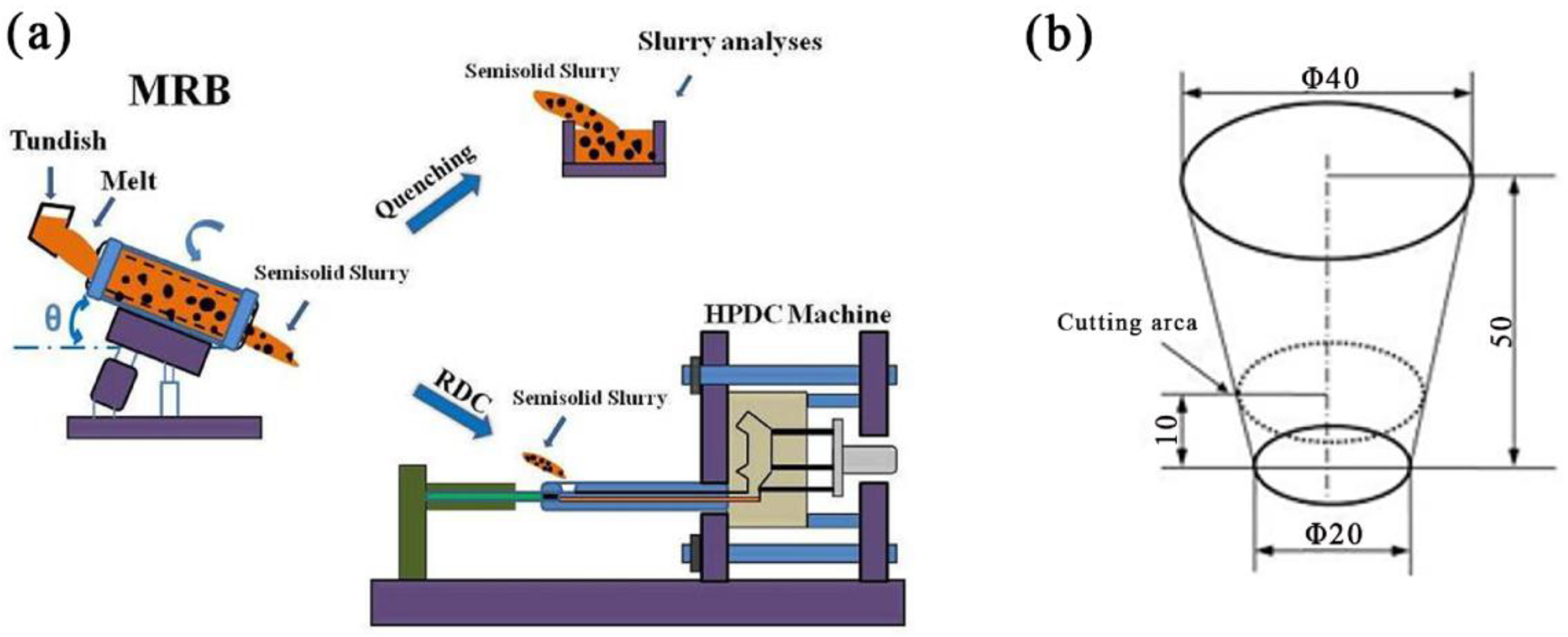

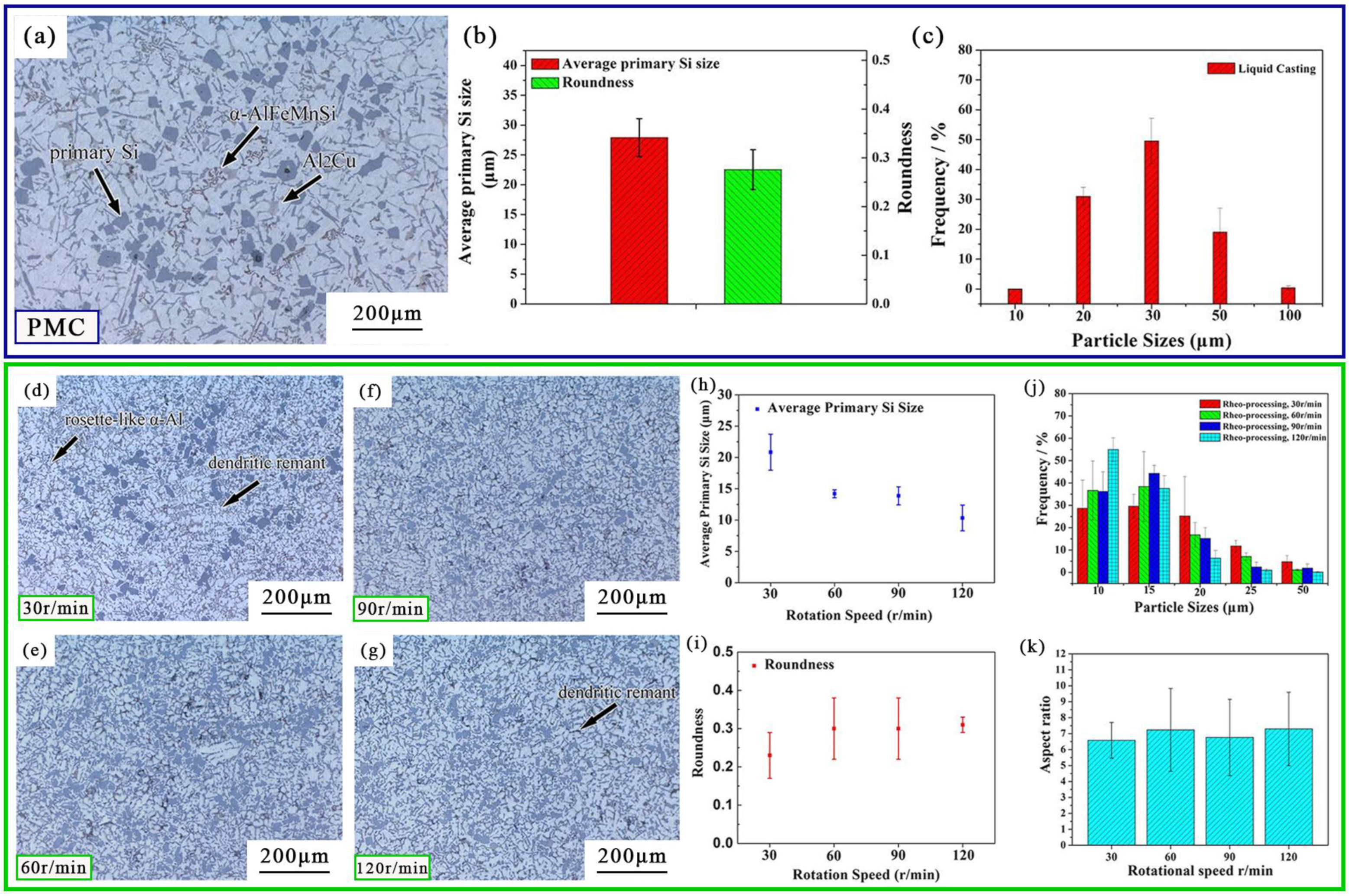

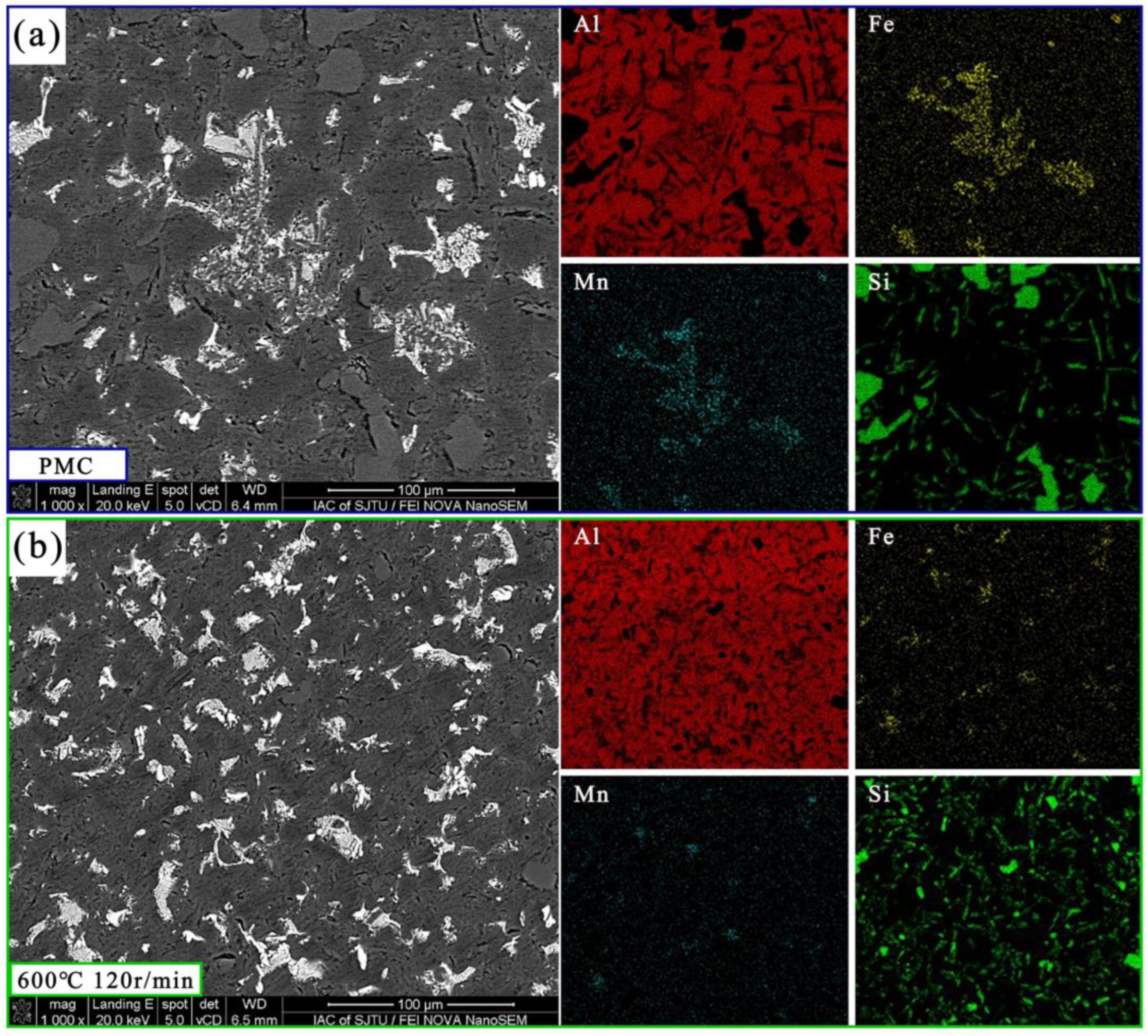

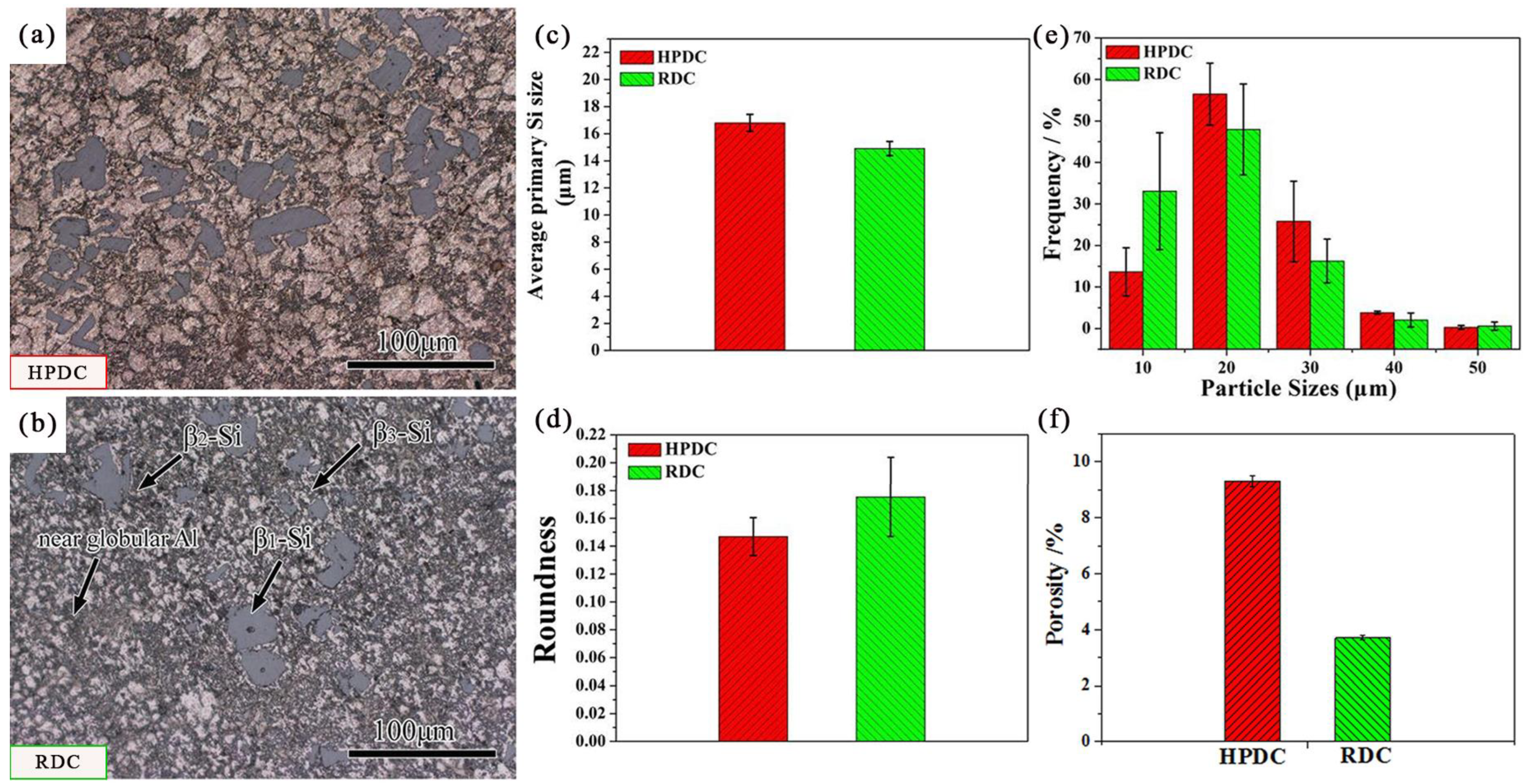
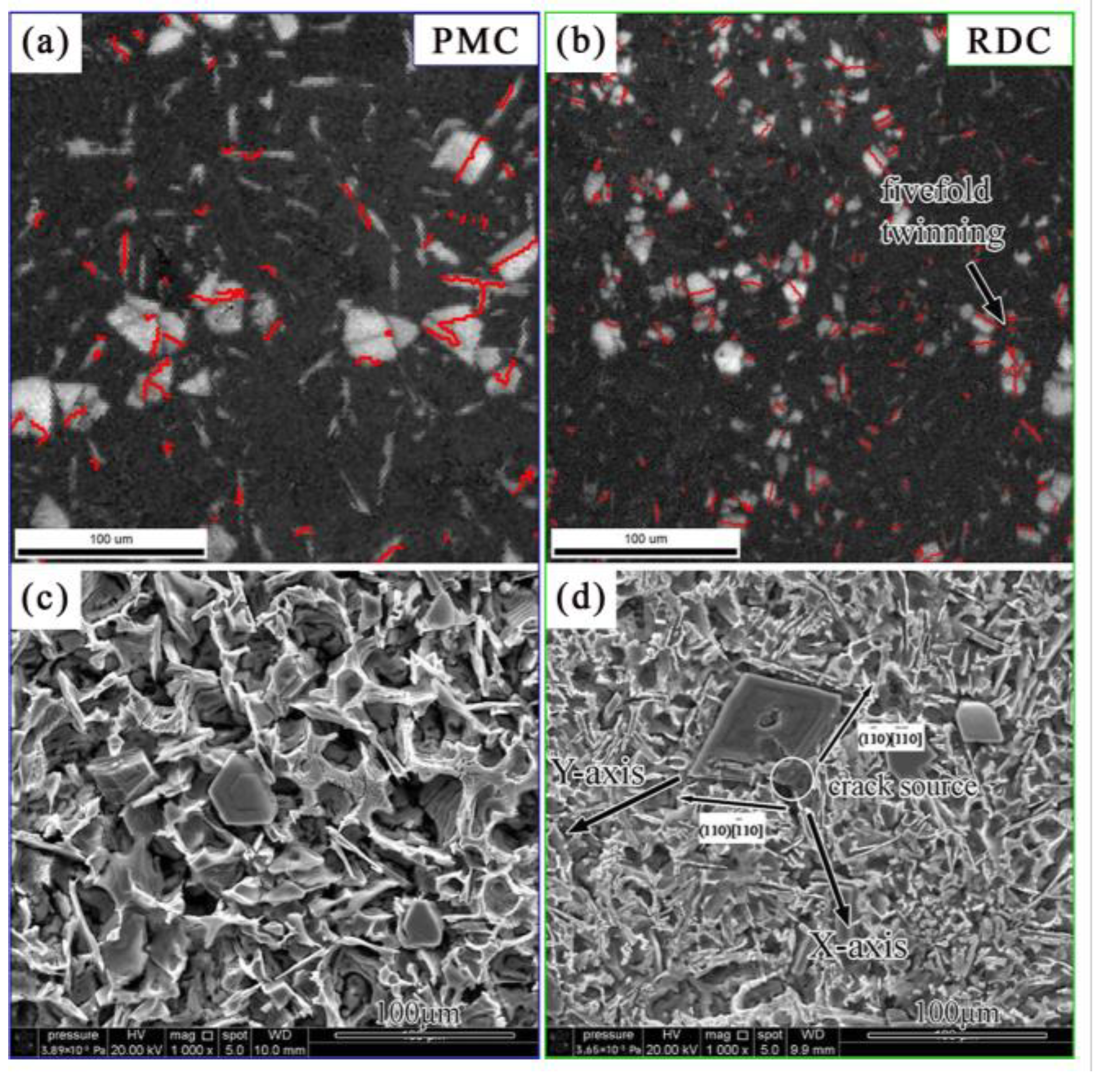
| Alloy | Si | Cu | Mg | Mn | Fe | Al |
|---|---|---|---|---|---|---|
| Al-15Si-4Cu-0.5Mg | 14.72 | 3.67 | 0.49 | 0.13 | 0.72 | balanced |
| Rotational Speed (r/min) | Pouring Temperature (°C) | Temperature at the End of the Barrel (°C) | Temperature Drop (°C) | Cooling Rate on Barrel (°C/S) |
|---|---|---|---|---|
| 30 | 660 | 622 | 38 | 34.5 |
| 60 | 660 | 619 | 41 | 37.2 |
| 90 | 660 | 617 | 43 | 39.1 |
| 120 | 660 | 614 | 46 | 41.8 |
| Pouring Temperature (°C) | Rotational Speed (r/min) | Temperature at the End of the Barrel (°C) | Temperature Drop (°C) | Cooling Rate on Barrel (°C/S) |
|---|---|---|---|---|
| 660 | 60 | 619 | 41 | 37.2 |
| 640 | 60 | 608 | 32 | 24.6 |
| 620 | 60 | 606 | 14 | 9.3 |
| 600 | 60 | 591 | 9 | 5.6 |
| Processing Conditions | Yield Strength (MPa) | Ultimate Tensile Strength (MPa) | Elongation (%) |
|---|---|---|---|
| HPDC, F | 280 | 304 | 0.4 |
| RDC, F | 288 | 326 | 0.6 |
| RDC, T6 | 391 | 411 | 0.8 |
Disclaimer/Publisher’s Note: The statements, opinions and data contained in all publications are solely those of the individual author(s) and contributor(s) and not of MDPI and/or the editor(s). MDPI and/or the editor(s) disclaim responsibility for any injury to people or property resulting from any ideas, methods, instructions or products referred to in the content. |
© 2023 by the authors. Licensee MDPI, Basel, Switzerland. This article is an open access article distributed under the terms and conditions of the Creative Commons Attribution (CC BY) license (https://creativecommons.org/licenses/by/4.0/).
Share and Cite
Hu, Z.; Huo, Q.; Chen, Y.; Liu, M.; Chen, X. Improving Mechanical Property of Hyper-Eutectic Al-Si Alloys via Regulating the Microstructure by Rheo-Die-Casting. Metals 2023, 13, 968. https://doi.org/10.3390/met13050968
Hu Z, Huo Q, Chen Y, Liu M, Chen X. Improving Mechanical Property of Hyper-Eutectic Al-Si Alloys via Regulating the Microstructure by Rheo-Die-Casting. Metals. 2023; 13(5):968. https://doi.org/10.3390/met13050968
Chicago/Turabian StyleHu, Zhaohua, Qile Huo, Yaxin Chen, Manping Liu, and Xuefei Chen. 2023. "Improving Mechanical Property of Hyper-Eutectic Al-Si Alloys via Regulating the Microstructure by Rheo-Die-Casting" Metals 13, no. 5: 968. https://doi.org/10.3390/met13050968
APA StyleHu, Z., Huo, Q., Chen, Y., Liu, M., & Chen, X. (2023). Improving Mechanical Property of Hyper-Eutectic Al-Si Alloys via Regulating the Microstructure by Rheo-Die-Casting. Metals, 13(5), 968. https://doi.org/10.3390/met13050968






